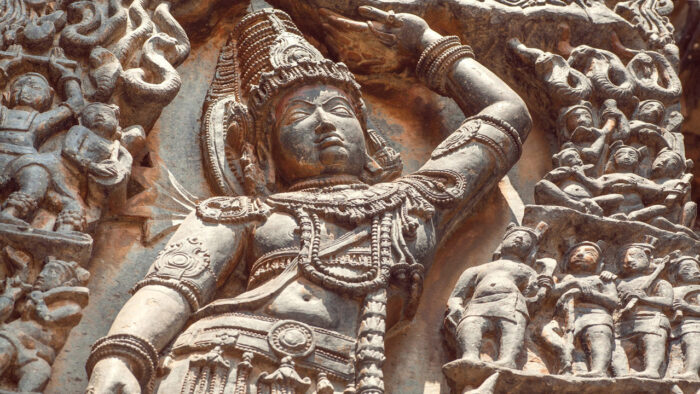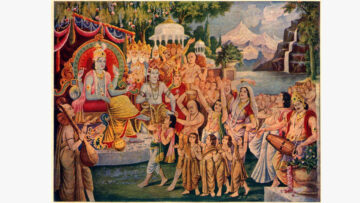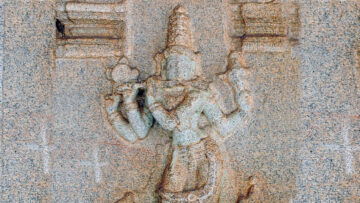Inner Identity and the Meditative Self – Reflections from the Gītā
“You are not what you remember. You are the quiet presence that remembers.”
Introduction
Have you ever found yourself thinking about the same painful moment over and over again? Maybe something someone said, a failure that hurt, or a situation you wish had gone differently. You tell yourself it’s in the past, but somehow, it keeps showing up in your thoughts. Slowly, without even realizing it, the memory stops being just something that happened. It starts to feel like a part of who you are.
This is not uncommon. It begins subtly. A thought brings a wave of emotion. That emotion strengthens the thought. The cycle continues. Over time, you don’t even question it. It becomes the background noise of your day, shaping how you see yourself, how you act, and how you relate to others.
What was once an experience turns into a personal identity. The pain becomes a lens through which you see everything. And because it feels so familiar, it feels real. The mind repeats the story until it becomes your story.
But what if it’s not who you are? What if it’s just a loop that started long ago and never got interrupted?
This article is about seeing that loop for what it is. It’s about stepping back, even slightly, to ask the question we rarely ask: Is this pain really me, or is it just something I’ve been living with for too long?
The Anatomy of the Thought Loop
Let’s take a closer look at what really happens when a painful thought keeps coming back. It usually begins with something small. A memory. A feeling. A thought that seems harmless at first. But then, that thought brings a familiar emotion. It could be sadness, anger, or regret. That emotion feeds the thought, and suddenly, you’re deep in it.
This happens without warning. You’re thinking about the past, and before you know it, you’re not just remembering it. You’re reliving it. Your body reacts, your mood shifts, and your focus is gone. You’re no longer in the present moment. You’re caught in something that already happened, maybe even years ago.
That’s how the loop begins. One thought leads to one feeling. That feeling pulls up another thought. And the cycle goes on. Day after day, this loop repeats. It starts to feel normal. After a while, it becomes so automatic that you may not even notice it happening.
The problem is not the original experience. That may have hurt, yes. But the deeper pain is in the repetition. The mind keeps going back to it. It keeps trying to understand it, fix it, or explain it. But instead of helping, this only strengthens the loop.
And the more the loop repeats, the more it shapes your inner world. It decides how you see yourself. You start saying things like, “This always happens to me,” or “I’ll never get over it.” These thoughts feel like facts. But they’re just part of the pattern.
At some point, the loop no longer needs your permission. It runs on its own. You may even think you are being reflective. But in reality, you are stuck in the same circle, over and over again.
Below are some examples of signs You’re Stuck in a Thought Loop
- Repeating the same painful memory over and over
- Constant self-blame or second-guessing past choices
- Obsessing about what others think of you
- Feeling trapped in emotional over-analysis
- Knowing it’s unhelpful but unable to stop
Painful thoughts on repeat don’t seek answers. They seek your identity.
Understanding how this loop works is the first step. If you can see the pattern, you can begin to break it. You don’t need to fight the thoughts. You just need to recognize what they are doing. And that awareness changes everything.
From Memory to Identity
It’s one thing to remember a painful moment. It’s another thing to live through it again and again until it feels like a part of who you are. That’s what often happens when the thought loop stays active for too long. The memory starts as a single event. But when the mind keeps revisiting it, that memory turns into something more. It becomes personal. It becomes an identity.
Let’s say someone was betrayed in a close relationship. At first, there’s hurt, confusion, maybe anger. That’s natural. But if the story of that betrayal keeps replaying in the mind, it begins to shape how that person sees themselves. They might start thinking, “I’m someone who gets betrayed,” or “I can’t trust anyone.” With time, these thoughts stop being reactions and start feeling like truths.
The real shift happens quietly. There is no sudden moment when a memory becomes identity. It just happens little by little. The more you think about what happened, the more your sense of self gets linked to it. And without noticing, you begin to carry that experience into new situations.
You might walk into new relationships with doubt already in place. You might hold back, stay guarded, or expect to be hurt. Not because it’s happening again, but because the old story is still alive inside. That’s how the past becomes your present.
This is where the loop gets stronger. Every new emotion seems to confirm the old story. And the more it is confirmed, the more it feels like who you are. The mind doesn’t just remember. It builds a role around the pain. Maybe the role of the victim. Or the role of someone who was wronged. These roles feel safe because they are familiar.
But they are also limiting. They shape your choices. They keep you from seeing clearly. Most of all, they take away the space to be something else, something more than the old pain.
To begin shifting out of this, you don’t have to erase the past. You just need to see that it is a part of your story, not the whole of who you are. Once that becomes clear, the story starts to loosen its grip. And that’s when healing begins.
The Role of the Ego: Comfort in the Familiar
Let’s pause and look at the ego. Not the loud kind that boasts, but the quieter part of us that wants to hold on to a steady sense of self. It builds our story and tells us who we are. Even when that story includes pain, the ego prefers it over the unknown, because at least it feels familiar.
That’s why letting go of an old hurt can feel like losing something real. The ego whispers, “This is who I am. This is what I’ve been through.” These roles; wounded, wronged, misunderstood become our emotional identity. Even when they hurt, they feel like home.
The ego’s job isn’t to hurt us. It wants safety. So, it puts up walls around our identity. It says, “Stay here. You know this place.” But that safety soon becomes a cage. We stop exploring who we really are. We stay in the loop, not because it’s good, but because it’s known.
Sometimes, the pain itself becomes a badge. We defend our past, not just because of the memory, but because it defines us. And without that story, we fear we might not know who we are.
When the Ego clings to familiar pain we start
- Justifying our emotional state as “just who I am”
- Getting defensive when someone challenges our view
- Secretly feeling safe in sorrow or resentment
- Turning inner wounds into our life story
- Finding comfort in the predictability of suffering
The ego prefers familiar pain over unfamiliar peace.
But we are not our hurt. We are not our history. When we begin to see the ego’s pattern, we don’t have to fight it. We just stop following it. That’s when something deeper starts to open up; space for change, for quiet, for freedom.
Insight from the Bhagavad Gītā
Śhrīmad Bhagavad Gītā offers deep wisdom about the mind, the self, and the struggle between them. One verse that stands out in this context is Chapter 6, Verse 5.
उद्धरेदात्मनात्मानं नात्मानमवसादयेत् ।
आत्मैव ह्यात्मनो बन्धुरात्मैव रिपुरात्मनः ॥ BG ६.५ ॥
uddharēdātmanātmānaṁ nātmānamavasādayēt |
ātmaiva hyātmanō bandhurātmaiva ripurātmanaḥ || BG 6.5 ||
(One must uplift oneself through self-effort and not degrade oneself. The self is both the friend and the enemy of an individual. A disciplined and enlightened mind becomes one’s greatest ally, while an uncontrolled mind becomes one’s greatest adversary.”)
This is a simple but powerful reminder. The mind can either help us rise or hold us down. It all depends on how we relate to it. When the mind is filled with repeated stories of pain, it begins to act like an enemy. Not out of cruelty, but out of habit. It keeps showing us the same images, the same emotions, the same meanings. And slowly, we start to live as if those thoughts are only the truth.
But the Gītā invites us to look deeper. It teaches that there is something within us that is not touched by thoughts or pain. That inner self is pure awareness. It watches, it sees, but it does not get pulled in. The challenge is not to stop thinking, but to stop believing that every thought defines who we are.
Śhrī Kṛiṣhṇa also reminds Arjun, in different verses, that the real battle is within. It is between the changing mind and the steady self. Between the roles we play and the presence that simply is. When we get caught in the loop of pain, we are pulled by the restless mind. But when we step back and witness it, we start to discover a space that feels peaceful, even in the middle of confusion.
This is not just philosophy. It is a real and personal practice. To lift the mind, we must first become aware of what it’s doing. That awareness itself is strength. It is the beginning of freedom. And as the Gītā shows us, freedom doesn’t come from escaping life. It comes from seeing clearly, acting wisely, and remembering who we truly are behind the thoughts.
A Real-Life Shift: Riya’s Silent Room: Riya lost her son in a road accident when he was just sixteen. In the years that followed, she smiled, worked, even attended family functions, but something inside her had gone completely quiet. Her house still had his shoes by the door. His room remained untouched. But more than the room, it was her mind that became a shrine of sorrow. Every day she would sit silently in that room, not to remember him, but to revisit the pain. The accident, the call, the drive to the hospital; it looped in her thoughts like a reel that would never stop.
She began to identify with that pain. If someone asked who she was, her heart would answer, “a mother who lost her child.” Nothing else seemed truer than that.
One evening, sitting on the floor of his room, she noticed the way the sunlight hit the edge of his old study table. It wasn’t the table, nor the sunlight, but the sudden stillness that caught her attention. In that quiet moment, something softened. For the first time, she didn’t cry. She didn’t talk. She simply watched.
That evening didn’t erase the pain. But something in her began to understand that she was more than what happened. That she could love him without becoming only her grief. Over time, she didn’t stop visiting the room; but she no longer went there to suffer. She went to sit in silence. And that silence, once full of ache, slowly began to hold peace.
Consciousness: The Silent Witness
There is a part of you that watches everything. It sees your thoughts, your feelings, your memories, and even your reactions. It does not comment, it does not judge, and it does not get pulled into the story. This part is what we call consciousness. It is not loud, but it is always there.
Most of the time, we are so caught up in our thinking that we forget this presence exists. We believe we are the thoughts themselves. But the moment you pause and simply observe what is happening in your mind, something shifts. You are no longer just the thinker. You are the one who is aware of thinking.
This space of awareness is quiet. It does not react. It does not try to change anything. It just sees things as they are. And in that seeing, something powerful happens. The grip of the thought starts to loosen. The loop begins to slow down, even if just a little.
As the Gītā expresses it, true peace arises not from the absence of emotions, but from the ability to remain inwardly unmoved, like the vast ocean into which all rivers flow.
आपूर्यमाणमचलप्रतिष्ठं समुद्रमापः प्रविशन्ति यद्वत् ।
तद्वत्कामा यं प्रविशन्ति सर्वे स शान्तिमाप्नोति न कामकामी ॥ BG २.७० ॥
āpūryamāṇamacalapratiṣṭhaṁ samudramāpaḥ praviśanti yadvat |
tadvatkāmā yaṁ praviśanti sarvē sa śāntimāpnōti na kāmakāmī || BG 2.70 ||
(Just as the ocean remains undisturbed despite countless rivers flowing into it, a wise person remains unshaken despite the continuous influx of desires, attaining true peace, unlike those who chase desires.)
You don’t need to work hard to find this awareness. It is not something you have to create. It is already there. Even in moments of stress or sadness, it is still present in the background. What helps is to stop feeding every thought with attention. When a thought comes, you can choose to watch it instead of follow it.
Over time, this simple shift brings more space inside. You begin to notice that not every thought needs a response. Not every feeling needs a story. Some things can just come and go.
This silent witness within you is not cold or distant. It is calm and clear. And it holds the key to stepping out of the loop. When you rest in that space, even for a few moments, you remember that you are more than your mind. You are the one who sees.
Emotional Loops in Relationships and Groups
Sometimes, the thought loops we carry quietly inside begin to echo through our relationships. What starts as an internal discomfort shows up as tension, blame, or distance with others. Often, it’s not the situation that triggers us, but the meaning we attach to it based on our old pain. When someone forgets to reply to a message or doesn’t meet our expectations, the mind might whisper, “See, I don’t matter,” or “People always leave.” These interpretations feel real because they match the old stories we’ve held for years.
When two people carry unresolved loops, their pain patterns can feed each other. One withdraws to feel safe, while the other pursues to feel heard. Each reacts not just to the moment, but to the past playing out again. Over time, these repeated patterns create a kind of emotional script. Even in groups or families, the loop can become collective. A shared belief like “we must keep peace at all costs” or “no one ever listens here” becomes the invisible rule.
The trouble is that these loops keep us reacting instead of responding. We stop seeing the person in front of us and start interacting with the story in our heads. That’s why healing in relationships often begins with self-awareness. The more we understand our own emotional patterns, the less likely we are to act them out unconsciously with others. When just one person in the loop pauses, breathes, and sees clearly, the whole pattern begins to soften.
This happens more often than we think. Political groups, social movements, even families can fall into this pattern. The shared story of pain becomes a shield and a structure. But over time, it also becomes a limitation.
Whether in a relationship or a group, the first step out of this loop is awareness. Someone has to pause and ask,
“Are we still reacting to the present, or are we just repeating the past?”
That one question can open a door. It invites honesty. It invites healing. And it creates space for something new to grow.
The Trap of False Forgiveness
Sometimes we feel we must forgive because it’s the right thing to do. We tell ourselves it’s time to move on. But deep down, we may still hold the same pain, the same anger. This is what creates the trap of false forgiveness.
False forgiveness is when the words are spoken, but the emotions remain untouched. It may look like peace on the outside, but inside, the loop continues. The story still runs in the mind. The wound still defines the relationship or the memory. Forgiveness, when forced or rushed, becomes another way of avoiding what is really felt.
Real forgiveness is different. It doesn’t come from pressure. It comes from understanding. When you begin to see the pain without attaching a personal label to it, something softens. You start to see that others often act from their own patterns and pain, not with full awareness. This doesn’t excuse the harm, but it helps you step back from constant blame.
Forgiveness doesn’t mean forgetting. It means no longer carrying the past as a burden. When it is real, there is no need to prove anything or hold anything. The heart begins to let go, not out of duty, but out of clarity.
Below are some examples of missteps of false forgiveness
- Saying “I’ve moved on” but still holding resentment
- Forgiving only to prove moral superiority
- Avoiding confrontation under the label of forgiveness
- Expecting others to change as a condition to forgive
- Using forgiveness to escape deeper reflection
True forgiveness heals. False forgiveness hides.
True forgiveness is not a performance. It is a quiet shift inside, where the need to protect the old story fades away. And in that space, healing begins.
As the Gita describes, true forgiveness (kṣhamā) is part of a deeper inner character; born from fortitude, purity, and the absence of hatred. It is not rushed or artificial, but a reflection of divine strength from within.
तेजः क्षमा धृतिः शौचमद्रोहो नातिमानिता ।
भवन्ति सम्पदं दैवीमभिजातस्य भारत ॥ BG १६.३ ॥
tējaḥ kṣamā dhr̥tiḥ śaucamadrōhō nātimānitā |
bhavanti sampadaṁ daivīmabhijātasya bhārata || BG 16.3 ||
(“Vigor, forgiveness, fortitude, cleanliness, freedom from malice, and absence of pride; these qualities, O Bhārata, are the qualities of one born to a divine disposition..”)
Breaking the Loop: What Real Transformation Looks Like
Real transformation doesn’t always look dramatic. It often begins with small, quiet shifts. A pause before reacting. A breath taken instead of a harsh word. A moment of clarity in the middle of confusion. These tiny choices are where the loop begins to lose its power.
The first step is recognition. Seeing the loop for what it is, without judgment. Then comes willingness. Not the pressure to change overnight, but the honest intention to do things differently. When we notice our mind returning to the same hurt or resentment, we can pause and ask, “Is this still true today, or is it just familiar?”
Letting go isn’t forgetting. It’s remembering who we are without the weight of that old story. It’s choosing presence over protection. We stop feeding the loop by becoming more conscious of the space between thought and action. That space is where freedom lives.
Below are some of the early signs of real transformation
- Awareness of when a loop is beginning
- Taking a pause before reacting emotionally
- Releasing the need to always be right
- Feeling less identified with old pain stories
- Starting to observe your mind with gentle distance
In the Gita, Śhrī Kṛiṣhṇa guides the seeker to gently bring the wandering mind back, again and again, to inner stillness; reminding us that transformation is a process of repeated return, not one of sudden escape.
यतो यतो निश्चरति मनश्चञ्चलमस्थिरम् ।
ततस्ततो नियम्यैतदात्मन्येव वशं नयेत् ॥ BG ६.२६ ॥
yatō yatō niścarati manaścañcalamasthiram |
tatastatō niyamyaitadātmanyēva vaśaṁ nayēt || BG 6.26 ||
(Whenever and wherever the restless and unsteady mind wanders, one should consistently bring it back under control, firmly focusing it upon the Self.)
Transformation begins not with force, but with honest presence.
As our awareness grows, the grip of pain loosens. We begin to live more from the present than from the past. That’s what real change feels like. Not forced. Not rushed. Just honest, steady, and alive.
“The loop loses its rhythm when you no longer dance to its tune.”
Conclusion
Painful experiences leave marks, but they don’t have to become our whole story. Many of us carry memories that were never fully healed. Over time, those memories turn into thoughts, and those thoughts turn into identity. We forget that we are more than what happened to us.
This article was not about denying pain. It was about seeing clearly how the mind can trap us in it. The same thoughts repeat. The same emotions return. And slowly, the past begins to feel like who we are.
But the moment we become aware of this pattern, something shifts. Even a small moment of awareness can begin to loosen the loop. We start to see the thought, not just feel it. We begin to remember that we are not the story. We are the space in which the story plays.
Freedom is not far away. It starts the moment we stop fighting and start observing. The pain may still be there, but it no longer leads the way.
You are not the loop. You are the awareness in which it plays and from that awareness, you can step out of the cycle and into freedom.
So here’s a quiet question to sit with:
If the old story no longer runs your life, who might you become?
That answer will not come from the mind. It will come from the silence that sees it all.
Further Reading
1. The Teaching of the Bhagavad Gītā – Swami Dayananda Saraswati
A profound and structured exposition of the Gītā, focusing on self-knowledge, freedom from psychological suffering, and the role of the inner observer.
2. The Bhagavad Gītā – Swami Chinmayananda
A clear and insightful commentary that connects ancient teachings to inner struggles, especially around ego, detachment, and self-mastery.
3. I Am That – Talks with Sri Nisargadatta Maharaj
A powerful collection of dialogues pointing to the Self beyond suffering and identity. Helps shift perspective from the thinker to the witness.
4. The Untethered Soul – Michael A. Singer
An accessible guide to observing your thoughts, emotions, and inner voice without clinging or resistance.
5. Wherever You Go, There You Are – Jon Kabat-Zinn
Introduces the practice of mindfulness in everyday life. Offers practical approaches for breaking mental loops through presence.
6. Letting Go: The Pathway of Surrender – David R. Hawkins
Explores how suppressed emotions and internal resistance contribute to identity loops, and how gentle surrender brings inner freedom.
(Note on Sources: This article is inspired by Chapter 06 of the Bhagavad Gītā: Dhyān Yog (The Yog of Meditation), and draws from both classical commentaries and modern contemplative insights. The ideas presented are influenced by the teachings of spiritual masters such as Swami Dayananda Saraswati , Swami Chinmayananda, Sri Nisargadatta Maharaj, and others who have interpreted the path of meditation as a means to inner stillness and self-mastery. While this article adapts those ideas for contemporary life, its reflections remain rooted in the original Sanskrit verses and honor the deep meditative wisdom that this chapter offers.)
Feature Image Credit: istockphoto.com
Disclaimer: The opinions expressed in this article belong to the author. Indic Today is neither responsible nor liable for the accuracy, completeness, suitability, or validity of any information in the article.










